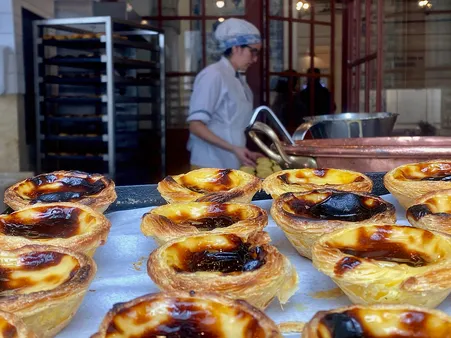Table of Contents
When it comes to traditional Portuguese desserts, few are as beloved as the nata portuguese dessert, also known as Pastel de Nata. This delicious egg custard tart pastry has been a staple of Portuguese cuisine for centuries, and its popularity has spread far beyond the country's borders. At tauhuichiban, we're excited to take you on a journey through the history and cultural significance of this iconic dessert, as well as provide you with a recipe to make the perfect Nata Portuguese dessert at home.
History | Originated in Belém, Lisbon, by Catholic monks at the Jerónimos Monastery |
|---|---|
Recipe | Requires puff pastry dough, whole milk, whipping cream, sugar, salt, egg yolks, and vanilla extract |
Popular Variations | Egg tart, custard tart, and adopted by KFC in some regions |
Cultural Significance | Recognized as one of Portugal's Seven Wonders of Gastronomy and listed as one of the 50 "best things to eat" in the world by The Guardian |

Discover The Rich History And Deliciousness Of Nata Portuguese Dessert
Nata Portuguese Dessert History and Origins
The Birthplace of Nata
The Nata Portuguese dessert has a rich history that dates back to the 18th century in Belém, Lisbon, Portugal. This iconic pastry was born in the Jerónimos Monastery, where Catholic monks created the recipe to use up leftover egg yolks. Can you imagine a world without Nata? Thankfully, these creative monks saved us from that fate!
The Original Recipe
The original recipe for Pastéis de Belém, as they're called in Portugal, remains a closely guarded secret to this day. The monks sold these delicious pastries to raise revenue after the Liberal Revolution of 1820 and the subsequent closure of religious institutions. Who knew that a pastry could be a game-changer in history?
Year | Event |
|---|---|
18th century | Nata Portuguese dessert was created by Catholic monks in Belém, Lisbon |
1820 | Liberal Revolution led to the closure of religious institutions, and the monks started selling Pastéis de Belém to raise revenue |

Nata Portuguese Dessert History and Origins
Popular Variations and Adaptations of Pastel de Nata
Traveling Tarts: From Portugal to Asia
You know how when you travel, you find different versions of your favorite foods? Well, the same thing happened with our beloved Nata Portuguese dessert! When Portuguese explorers went to places like Macau and Hong Kong, they brought their tasty tarts with them. These Asian versions are called "egg tarts" or "dan tat," and they're a mix of European baking techniques and yummy Asian flavors. It's like a culinary mashup that makes your taste buds dance!
Fast Food Fun: KFC's Twist on Tradition
Imagine walking into KFC and instead of seeing buckets of chicken, you see trays of egg custard tarts! In some parts of the world, like China, Taiwan, and Thailand, that's exactly what happens. KFC has adopted the Nata Portuguese dessert as part of their menu. It's kind of funny to think about Colonel Sanders serving up something so sweet and traditional from Portugal. But hey, who doesn't love a good surprise in their fast food?
Region | Variation Name |
|---|---|
Asia | "Egg tart" or "dan tat" |
(KFC adaptation in China, Taiwan, Thailand) |

Popular Variations and Adaptations of Pastel de Nata
Making the Perfect Nata Portuguese Dessert at Home
Now that we've explored the rich history and cultural significance of Nata Portuguese dessert, it's time to get our hands dirty and make some delicious pastries at home! Don't worry if you're not a pro baker – with these simple tips and tricks, you'll be whipping up flaky, creamy Nata in no time.
Ingredient | Quantity |
|---|---|
Puff Pastry Dough | 1 sheet |
Whole Milk | 1 cup |
Whipping Cream | 1 cup |
First things first, preheat your oven to 390°F (199°C). While that's heating up, let's prepare our puff pastry dough. Roll it out into a large disc, about 1/8 inch thick. Don't worry if it's not perfect – a little imperfection adds character, right?
- Roll out puff pastry dough into a large disc
- Cut out circles of dough using a cookie cutter or the rim of a glass
- Place a spoonful of custard mixture in the center of each dough circle
Now it's time to fill our pastry cups with the creamy custard mixture. Simply combine whole milk, whipping cream, sugar, salt, egg yolks, and vanilla extract in a bowl. Stir until the mixture is smooth and creamy – no lumps allowed!
Pop those pastries into the oven and bake for 40-45 minutes, or until the edges are golden brown and the custard is set. And that's it! Your very own Nata Portuguese dessert, fresh from the oven. Enjoy!

Making the Perfect Nata Portuguese Dessert at Home
In conclusion, the Nata Portuguese dessert is a delicious and culturally significant treat that has captured the hearts of people around the world. Whether you're a foodie, a history buff, or simply someone who loves trying new desserts, this article has provided you with a comprehensive guide to understanding and making the perfect Pastel de Nata. So go ahead, give it a try, and indulge in the rich flavors and history of this beloved Portuguese dessert!